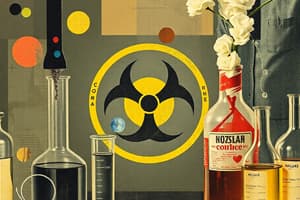Podcast
Questions and Answers
What is the significance of the wide range of chemicals used in research laboratories?
What is the significance of the wide range of chemicals used in research laboratories?
- The chemicals are chosen solely based on cost-effectiveness.
- They are all environmentally friendly and non-toxic.
- Each chemical has unique properties that contribute to various research outcomes. (correct)
- They enhance the aesthetic appeal of the laboratory.
What is a potential risk associated with the use of a wide range of chemicals in laboratories?
What is a potential risk associated with the use of a wide range of chemicals in laboratories?
- Inherent hazards that may pose safety threats. (correct)
- Increased stock inventory requirements.
- Improved research efficiency and results.
- Higher likelihood of chemical compatibility.
Which of the following statements about chemicals in research laboratories is most accurate?
Which of the following statements about chemicals in research laboratories is most accurate?
- Only non-hazardous chemicals are used in laboratories.
- Chemicals pose no risk when handled properly.
- All chemicals used are safe for any type of research.
- The hazards associated with chemicals can vary widely. (correct)
Why is it important to recognize the hazards of chemicals used in research?
Why is it important to recognize the hazards of chemicals used in research?
In a laboratory setting, what is one responsibility of the personnel handling chemicals?
In a laboratory setting, what is one responsibility of the personnel handling chemicals?
What is the primary purpose of understanding chemical hazards?
What is the primary purpose of understanding chemical hazards?
Which of the following is not a recommended precaution when handling chemicals?
Which of the following is not a recommended precaution when handling chemicals?
What should be a primary concern to prevent chemical exposure?
What should be a primary concern to prevent chemical exposure?
Why might personal experiences with chemical injuries be relevant to safety practices?
Why might personal experiences with chemical injuries be relevant to safety practices?
What is one consequence of failing to understand chemical hazards?
What is one consequence of failing to understand chemical hazards?
What is suggested as a method to counter the feeling of improbability?
What is suggested as a method to counter the feeling of improbability?
What effect does the feeling of improbability have according to the content?
What effect does the feeling of improbability have according to the content?
Which statement best captures the recommended mindset when faced with highly improbable situations?
Which statement best captures the recommended mindset when faced with highly improbable situations?
What mental trap is implied in the content when faced with unlikely scenarios?
What mental trap is implied in the content when faced with unlikely scenarios?
What is the primary emotional response that might stem from thinking that something is highly improbable?
What is the primary emotional response that might stem from thinking that something is highly improbable?
What type of misuse of chemicals should institutions primarily focus on preventing?
What type of misuse of chemicals should institutions primarily focus on preventing?
Which of the following activities might involve the intentional misuse of chemicals?
Which of the following activities might involve the intentional misuse of chemicals?
How can institutions mitigate the potential for chemical misuse?
How can institutions mitigate the potential for chemical misuse?
What is a key consideration for institutions regarding chemicals?
What is a key consideration for institutions regarding chemicals?
Which scenario exemplifies intentional misuse of chemicals?
Which scenario exemplifies intentional misuse of chemicals?
What was the underlying reason for establishing the GHS at the United Nations Conference on Environment and Development in 1992?
What was the underlying reason for establishing the GHS at the United Nations Conference on Environment and Development in 1992?
Which of the following ILO instruments prompted the need for a system of hazard classification and labeling?
Which of the following ILO instruments prompted the need for a system of hazard classification and labeling?
In the context of the GHS, what does the acronym 'ILO' stand for?
In the context of the GHS, what does the acronym 'ILO' stand for?
What significant global event in 1992 led to the development of the GHS?
What significant global event in 1992 led to the development of the GHS?
What primary aspect did the adoption of the ILO Chemicals Convention necessitate?
What primary aspect did the adoption of the ILO Chemicals Convention necessitate?
What is primarily responsible for determining the hazard of a flammable liquid?
What is primarily responsible for determining the hazard of a flammable liquid?
Which of the following factors does NOT contribute to the hazard associated with a flammable liquid?
Which of the following factors does NOT contribute to the hazard associated with a flammable liquid?
How does the flash point of a flammable liquid impact its hazard level?
How does the flash point of a flammable liquid impact its hazard level?
Which of the following statements about ignition temperature is true?
Which of the following statements about ignition temperature is true?
In assessing flammable liquids, which statement is accurate regarding the flammability limit?
In assessing flammable liquids, which statement is accurate regarding the flammability limit?
Flashcards
Laboratory Chemical Hazards
Laboratory Chemical Hazards
The use of chemicals in research laboratories presents specific risks due to the variety of substances and their inherent properties.
Research Chemical
Research Chemical
A substance used in research laboratories. Each chemical has its own set of potential risks.
Inherent Hazard
Inherent Hazard
A property of a chemical that can cause harm. This can include fire hazards, health risks, or environmental damage.
Research Laboratories
Research Laboratories
A collection of scientific facilities that are dedicated to research and development.
Signup and view all the flashcards
Research
Research
The process of conducting research and development using scientific methods and tools.
Signup and view all the flashcards
Chemical Hazards
Chemical Hazards
The dangers associated with chemicals, such as fire, explosion, toxicity, or reactivity.
Signup and view all the flashcards
Chemical Precautions
Chemical Precautions
Steps taken to minimize risk of exposure and accidents when handling chemicals.
Signup and view all the flashcards
Chemical Exposure
Chemical Exposure
Coming into contact with a chemical, either directly or through inhalation, ingestion, or absorption.
Signup and view all the flashcards
Chemical Mishaps
Chemical Mishaps
An unexpected incident involving chemicals that results in harm or damage.
Signup and view all the flashcards
Importance of Chemical Safety
Importance of Chemical Safety
The importance of understanding chemical hazards and taking appropriate precautions to prevent harm.
Signup and view all the flashcards
Highly Improbable Event
Highly Improbable Event
It's highly unlikely something will happen, making it easier to dismiss the possibility.
Signup and view all the flashcards
Improbable Event Trap
Improbable Event Trap
The tendency to avoid focusing on an event because it seems highly improbable.
Signup and view all the flashcards
Focusing on Likelihood
Focusing on Likelihood
A mental state where we focus on the likelihood of an event happening, even if it's not immediately probable.
Signup and view all the flashcards
Saying 'Yes, It Will Happen'
Saying 'Yes, It Will Happen'
The act of stating or believing that an event will occur, even if it seems improbable.
Signup and view all the flashcards
Accepting the Possibility
Accepting the Possibility
A strategy to avoid the improbable event trap by acknowledging the possibility of the event happening.
Signup and view all the flashcards
Accidental Chemical Misuse
Accidental Chemical Misuse
The potential for chemicals to be misused accidentally, such as through spills or improper handling.
Signup and view all the flashcards
Intentional Chemical Misuse
Intentional Chemical Misuse
The deliberate use of chemicals for illegal purposes, such as making explosives or drugs.
Signup and view all the flashcards
Chemicals for Illicit Drug Trafficking
Chemicals for Illicit Drug Trafficking
Chemicals used in the production of illegal drugs, often with harmful side effects.
Signup and view all the flashcards
Chemicals for Terrorism
Chemicals for Terrorism
Chemicals intentionally misused for acts of terrorism, such as creating explosives or poisons.
Signup and view all the flashcards
Importance of Chemical Security
Importance of Chemical Security
The importance of preventing both accidental and intentional misuse of chemicals to protect people and the environment.
Signup and view all the flashcards
GHS (Globally Harmonized System)
GHS (Globally Harmonized System)
A global system for classifying and labeling chemicals to ensure consistent communication of hazards and safe handling practices.
Signup and view all the flashcards
UN Conference on Environment and Development (1992)
UN Conference on Environment and Development (1992)
A 1992 United Nations conference focused on sustainable development, where the GHS was born.
Signup and view all the flashcards
International Labour Organization (ILO)
International Labour Organization (ILO)
A United Nations agency that promotes decent work and protects workers' rights, including workplace safety.
Signup and view all the flashcards
Hazard Classification
Hazard Classification
A system for classifying chemicals based on their hazards. It helps communicate the risks associated with chemicals.
Signup and view all the flashcards
Chemical Labeling
Chemical Labeling
A system for clearly labeling chemicals with standardized hazard symbols and information about risks and precautions.
Signup and view all the flashcards
Flash Point
Flash Point
The temperature at which a liquid gives off enough vapor to ignite when a source of ignition is present.
Signup and view all the flashcards
Flammability Limits
Flammability Limits
The range of concentrations of a flammable substance in air that will support combustion.
Signup and view all the flashcards
Ignition Temperature
Ignition Temperature
The minimum temperature at which a substance will ignite and continue to burn in air without a continuing source of ignition.
Signup and view all the flashcards
Flammability Hazard
Flammability Hazard
The degree of hazard associated with a flammable liquid, determined by its flash point, flammability limits and ignition temperature.
Signup and view all the flashcards
Flammable Liquid Safety
Flammable Liquid Safety
These factors define how easily a liquid can ignite and burn, affecting the risk of fire.
Signup and view all the flashcardsStudy Notes
Chemical Safety
- Chemical safety is crucial for preventing exposure to chemicals and mishaps in research laboratories
- Understanding potential hazards and precautions is paramount
- Accidents involving chemicals are unfortunately common, despite the improbable nature of them
- Avoiding the belief that "it won't happen" is crucial to prevent accidents
- A shift in mindset is necessary, focusing on preventative measures to avoid accidents
- Chemical safety and security is significant for institutions due to chemistry's role in our understanding of the physical and biological world
- Chemistry labs are centers for developing new materials for use in various fields (science, engineering, etc.)
- Chemicals used in manufacturing processes can benefit society but some pose potential harm
- Various threats exist, including theft of sensitive information, and high-value equipment theft
Security Risk Terms
- Hazard: A source that has the potential to cause harm
- Risk: The likelihood of an unwanted event involving a hazard or threat, and its consequences
- Perception of risk is critical
- Threat: A person or group intending to cause damage to an institution
- Asset: A valuable item from the perspective of a company or a potential threat
Chemical Security
- Chemical security focuses on preventing unauthorized access, loss, theft, misuse, diversion, or intentional release of hazardous materials or energy
- The acquisition of dual-use equipment or information could be used for chemical weapons
- Chemical safety protects people from chemicals
- Chemical security protects chemicals from people
Hazardous Materials
- Explosive materials, flammable materials, radioactive materials, pyrophoric solids, or liquids, are physical hazards
- Acute toxicity, carcinogenicity, mutagenicity, reproductive toxicology, and respiratory sensitizers are health hazards
- Incompatible chemical storage, high or low pressure, magnetic fields, and extreme temperatures are conditions hazards.
- Scale-up of a reaction, addition of a catalyst to a reaction, and storage/transportation of hazardous materials are activity hazards
- Chemical risks can have negative outcomes and harm if not properly monitored
Globally Harmonized System (GHS)
- GHS is an internationally recognized system for classifying chemical hazard criteria
- Includes criteria for classifying substances and mixtures based on physical, health, and environmental hazards
- Communication of hazards is through labels and safety data sheets (SDS)
- GHS is described in the "purple book", updated every two years, and available in the UN's official languages
GHS Hazard Pictograms
- GHS uses pictograms to illustrate various chemical hazards like Explosives, Flammable, Oxidizing, Compressed Gas, Corrosive, Toxic, Harmful, Health Hazard, Environmental Hazard
Additional Chemical Hazards
- Toxic substances, solvents, corrosives, flammables, irritants, carcinogens, teratogens, mutagens, explosives, and radiation are additional hazards
Chemicals as Hazards
- Corrosives: Cause destructive burns by chemical action, affecting respiratory and gastrointestinal tracts
- Oxidizers: Reacts readily under conditions generating oxygen, can cause explosions
- Flammables: Easily catch fire and burn in air; vapor released from flammable liquid can be a fire hazard; Flash point, flammability and ignition temperatures determine hazard level
Safety Precautions
- Laboratories generally need protocols for handling materials (don't work alone, unauthorized experiments are avoided, etc.)
- Equipment positioning, PPE usage, handling, knowledge of emergency equipment and hazards posed by others, proper heating and glassware cooling are crucial for safety
- Diluting acids/bases carefully, maintaining a clean, uncluttered work area, and following manufacturer's recommendations for equipment maintenance are necessary precautions
- Heating flammable and combustible materials should avoid open flames and utilize appropriate methods
Emergency Measures
- Chemical spills require evacuation of non-essential personnel, ventilation, and fire suppression if possible.
- Personal protective equipment and containment kits are used to contain and remove spills.
- Chemical splashes require immediate water flushing and contaminated clothing removal.
- Eyes must be flushed with copious water for at least 15 minutes.
Studying That Suits You
Use AI to generate personalized quizzes and flashcards to suit your learning preferences.




